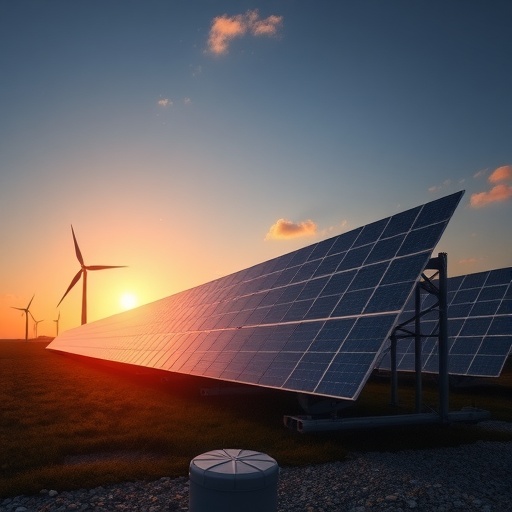In a groundbreaking advancement that could redefine the chemical industry’s environmental footprint, researchers from the University of Cambridge have unveiled a revolutionary solar-powered device designed to transform the way chemicals are synthesized. This innovative system synergizes organic semiconductors with bacterial enzymes in a semi-artificial leaf format that harnesses sunlight, water, and carbon dioxide to generate formate—a pivotal compound that serves as a foundational fuel for subsequent chemical syntheses. The breakthrough marks a significant stride toward the de-fossilisation of chemical manufacturing, a sector historically dependent on fossil feedstocks and responsible for approximately 6% of global CO2 emissions.
This biohybrid leaf mimics the natural photosynthetic processes found in plants but surpasses previous artificial designs by eschewing toxic or unstable light absorbers. Earlier iterations frequently incorporated heavy metals or inorganic semiconductors prone to degradation or environmental hazards. The current device’s organic polymer-based light-harvesting materials exhibit not only tunable optoelectronic properties but also enhanced longevity and biocompatibility, creating a sustainable avenue for solar-to-chemical energy conversion without the requirement of external electrical inputs or harmful additives.
Central to the success of the device is its integration of enzymes derived from sulphate-reducing bacteria, which catalyze the transformation of CO2 into formate with extraordinary specificity and efficiency. Unlike conventional synthetic catalysts, these biocatalysts operate under mild aqueous conditions, ensuring a clean reaction pathway with minimal side products. This selectivity is fundamental to the device’s ability to produce chemicals with high purity, thus reducing downstream purification challenges and energy expenditure.
A persistent challenge in enzymatic conversion systems has been the reliance on chemical buffers to stabilize enzyme activity, often leading to reduced operational lifespan and inefficiencies. The research team ingeniously incorporated carbonic anhydrase, an auxiliary enzyme, immobilized within a porous titania scaffold. This configuration allows the system to remain stable and effective in simple bicarbonate solutions reminiscent of natural sparkling waters, thus eliminating the drawbacks of previously necessary chemical additives and providing a more environmentally benign and cost-effective solution.
The architecture of this semi-artificial leaf is meticulously engineered at the nanoscale, wherein layers of organic semiconductors form a light-absorbing matrix complemented by enzyme immobilization strategies that facilitate optimal electron transfer. This “sandwich-like” configuration enhances the coupling between photogenerated electrons and enzymatic catalysts, enabling near-perfect current efficiencies for fuel synthesis while maintaining structural integrity over extended operational periods. Experimental evaluations demonstrate that the device consistently produces high current densities and sustains activity beyond 24 hours—more than double the endurance of prior models.
From a broader chemical engineering perspective, this technology offers a versatile platform capable of not only producing formate but also initiating further “domino” chemical reactions to yield pharmaceutically relevant compounds with remarkable yield and selectivity. By tapping into the modularity of enzymatic catalysis and organic semiconductor tuning, the semi-artificial leaf can be adapted to generate diverse chemical products, holding promise for scalable green manufacturing practices.
Professor Erwin Reisner, leading the interdisciplinary investigation, highlights the transformative potential of this development: “The chemical industry underpins a vast array of products essential to modern life, yet its fossil fuel dependency imposes severe environmental costs. Our semi-artificial leaf concept bridges biology and material science to create a self-sustaining, non-toxic chemical factory powered solely by sunlight—ushering in a new paradigm for chemical production.” The implications extend beyond sustainability, offering economic incentives through reduced energy inputs and minimized waste generation.
The research team’s approach also navigates away from rare and heavy metals, aligning with circular economy principles by focusing on earth-abundant, organic, and bio-derived materials. Notably, the device’s capacity to operate efficiently in benign conditions without additional chemical supports positions it as a realistic candidate for long-term deployment in decentralized or resource-limited settings, potentially spurring decentralized chemical manufacturing hubs powered by renewable energy.
Despite this progress, challenges remain in optimizing the device’s lifespan and expanding its chemical repertoire. Efforts are ongoing to further stabilize enzyme attachment, enhance photon absorption, and refine electron transport pathways. By tackling these engineering frontiers, the research envisions a suite of artificial leaves tailored for specific industrial chemical syntheses, accelerating the global transition toward sustainable chemical production.
This work, published in the influential journal Joule, sets a new benchmark in solar chemical synthesis, illustrating how interdisciplinary convergence between polymer engineering, enzymology, and materials science can yield tangible solutions to carbon-intensive industrial practices. The prospects for this technology resonate with global climate goals, as it offers a practical route to reduce emissions while meeting the chemical demands of a growing population.
Supported by prominent international scientific funding bodies including the European Research Council and the Singapore Agency for Science, Technology, and Research (A*STAR), this research exemplifies a global commitment to pioneering green chemistry methodologies. Its developmental success fortifies the conceptual and practical framework for biohybrid devices, carving a promising pathway for the next generation of sustainable, solar-driven chemical manufacturing.
As the world grapples with the urgent imperative to decarbonize industries, innovations such as this organic semiconductor-enzyme hybrid device herald a future where sunlight, ubiquitous and clean, becomes the cornerstone of chemical production. The semi-artificial leaf’s efficient and durable performance offers a glimpse into a circular economy powered by nature-inspired technologies, balancing human progress with planetary stewardship.
Subject of Research: Semi-artificial solar-driven devices for sustainable chemical synthesis using organic semiconductors integrated with bacterial enzymes.
Article Title: Semi-artificial leaf interfacing organic semiconductors and enzymes for solar chemical synthesis
News Publication Date: 10-Oct-2025
Web References: http://dx.doi.org/10.1016/j.joule.2025.102165
Image Credits: Celine Yeung
Keywords: Renewable energy, Solar energy, Chemistry, Chemical processes, Pharmaceuticals, Polymer engineering, Plastics




